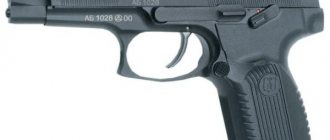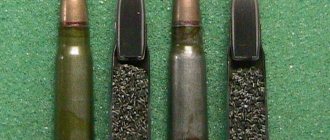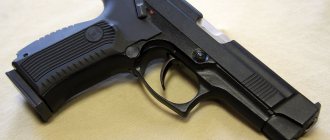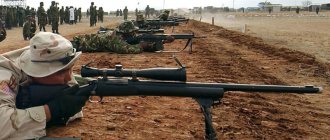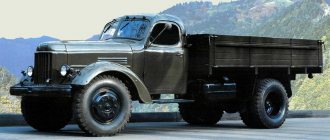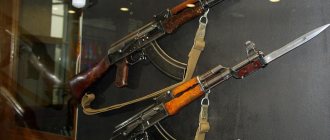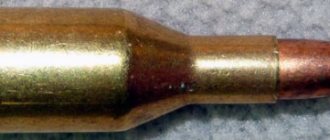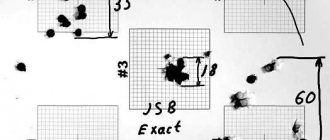History of the creation of explosive bullets
Explosive bullets are among the most controversial weapons used during World War II. Official sources are silent about their use, but memoir literature does not hide this. Similar cartridges were in service on both sides, but in limited quantities. Aviation was the main consumer of such complex and expensive products.
The types of ammunition used were not taken into account at the first stage of the war. Only in the summer of 1943 did doctors discover fragments of bullets in questionable wounds. The research results were communicated to the active army. Since information about the production of explosive cartridges is kept silent, we can conclude that they appeared along with firearms.
Bullets with a bursting charge were used to combat enemy aircraft in the 18th century and were made by converting a bullet with a spherical tip. The destruction of balloons required the use of a more shock-sensitive structure with a capsule protruding at the cut of the top, and to destroy durable equipment, its cap was recessed into a hole located at the top of the product. In 1916, bullets with explosive charges entered service with the British Army.
Effect of explosive bullets
There are many misconceptions associated with such cartridges. To understand what information is true, it is worth knowing what an explosive bullet device is. They consist of a shell, a primer, a firing pin, a fuse and an explosive.
The bullet is hit by the fact that it shatters into a large number of fragments. If they enter the body, a person has a chance of survival. However, such ammunition was prohibited for use against enemy personnel, but this does not apply to cases where the fight is against aviation and armored vehicles.
The explosive cartridge carries an explosive charge, which, if it hits an obstacle, detonates. These ammunitions do not cost much to produce, but are highly effective. To inflict significant losses on armored vehicles, you should not use bullets, because they cannot carry a sufficient charge for this. Although they are ideal for working against enemy air targets. Explosive bullets are varied in their design, but in most cases they have the same operating principle.
The device of cartridges
Live cartridge
(Fig. 38) consists of a cartridge case, a bullet, a powder charge and an igniter primer.
The cartridge weight is about 200 g.
Rice. 38. Live cartridge
Sleeve
(Fig. 39) consists of a body 1, inside which a powder charge is placed, a barrel 2, into which a bullet is inserted, a ramp 3, with which the cartridge is fixed in the chamber, and a flange 4 for capturing the cartridge case with the bolt when removing the cartridge from the receiver and the spent cartridge case from the chamber.
At the bottom of the cartridge case there is a socket a for the igniter primer, an anvil 5 on which the igniter primer is broken by the firing pin, and two seed holes b through which the flame from the igniter primer penetrates the powder charge.
Rice. 39. Sleeve:
1 — sleeve body; 2—case barrel: 3—case slope;
4 — sleeve flange; 5 - anvil; a - socket for
kalsulya-vosllamspitel; b - seed holes
Primer-igniter
(Fig. 40) consists of a brass cap 1 with impact compound 2 pressed into it and a foil circle 3 covering the impact compound.
Rice. 40. Primer-igniter:
1 — brass cap; 2 - shock composition;
3 - foil circle
Training cartridge
has a sleeve with longitudinal grooves on the body. In a training cartridge, the igniter primer is broken (cold), there is no powder charge in the cartridge case, and the bullet is an ordinary bullet casing that does not contain other elements of the bullet.
Oblong bullets
Oblong bullets are more advanced. They have a total length of 26 mm. Moreover, the total diameter is 14.9 mm, the diameter of the void is 5.5 mm, and its depth is 14 mm. 0.2 g of smoked powder is poured into a tube of sheet iron, which is inserted into a cylindrical channel. A primer is placed on the front of the tube, which goes deep into the bullet. To secure it in the bullet and prevent possible loss, lead is rolled onto the edge of the bullet. This product is used in rifled guns intended for hunting dangerous large animals. It is advisable for them to use 12-gauge explosive bullets, so they can stop a large animal.
Capping cartridges
Cartridges are delivered to military units in wooden boxes with tires, which have a stencil on the side wall containing the following data:
abbreviated name of cartridges;
information about the batch of cartridges;
gunpowder data;
distinctive stripe;
number of cartridges in the box.
For example, for 14.5 mm cartridges with an armor-piercing incendiary bullet B-32, the stencil on the side wall of the box looks like this (Fig. 47).
Rice. 47. Marking of live ammunition on the cap
The numbers and letters on the stencil mean:
14.5 B-32 GL - (14.5 - cartridge caliber, B-32 - name of the bullet, GL - brass sleeve);
B09-54-3 - data on the batch of cartridges. 84 pcs. — the number of cartridges in the box;
| - data on gunpowder |
The cargo category (number), hazard group sign (double triangle) and the weight of the box with cartridges are indicated on the box lid.
The cartridges are sealed in hermetically sealed galvanized boxes or welded iron boxes coated with paint.
There is a stencil on the box lid containing the same data as the stencil on the side of the box (except for the number of cartridges, which is not indicated on the box cover). Each box contains two boxes of ammunition. On the side wall of the box and the lid of the box with cartridges there is a distinctive sign indicating the range of cartridges.
Table of distinctive signs printed on cartridge boxes and boxes
| Name of cartridges | Distinctive marks on the soda boxes and boxes |
| 14.5 mm cartridges with armor-piercing incendiary bullet B-32 | Red and black stripes |
| 14.5 mm cartridges with BS-41 fire-fighting bullet | Two concentric rings in black. The end walls of the box and the lid up to the cross bars are painted black. |
| 14.5-mm cartridges with armor-piercing and fire-tracer bullets BZT | Stripes of red and purple |
| 14.5 mm cartridges with armor-piercing flammable-tracer BST bullet | Two concentric rings of purple color |
| 14.5 mm cartridges with ZP incendiary bullet | Red stripe |
| Instantaneous incendiary bullet MDZ | two red rings |
The stencil on the side walls of the boxes with training cartridges looks like this (Fig. 48).
Rice. 48. Marking of training cartridges on the closure
The numbers and letters on the stencil mean:
14.5 UCH GS - (14.5 - caliber of cartridges, UCH - purpose of cartridges, GS - steel sleeve);
B13-54-3 - data on the batch of cartridges;
112 pcs. — the number of cartridges in the box.
In addition, on the side of the drawer it says "Training"
Training cartridges are packed in boxes without boxes, 112 cartridges in each box.
Ushakov's explosive bullet
Ushakov's explosive bullet has a pin instead of a tube. In addition, the capsule is installed at the bottom of the cylindrical channel. Friction holds the front of the pin in the lead plug. To reduce sensitivity, it is shortened or moved further from the capsule. To use this ammunition for a smoothbore gun, it is necessary to ensure that the bullet flies with its head part forward. This can be done by attaching a tail made of wood.
Painting and branding of cartridges
To distinguish the cartridges, a distinctive color is applied to the bullets. Stamps are placed on the outer surface of the bottom of the sleeve.
Table of distinctive bullet colors
| Name of cartridges | Bullet coloring |
| 14.5 mm cartridges with B-32 bullet | The head of the bullet is black with a red belt |
| 14.5 mm cartridges with BS-41 bullets | The top of the bullet is black, the rest of the bullet up to the edge of the cartridge case is red |
| 14.5 mm cartridges with BZT bullets | The head of the bullet is purple with a red belt |
| 14.5 mm cartridges with BST bullet | The top of the bullet is purple, the rest of the bullet up to the edge of the cartridge case is red |
| 14.5 mm cartridges with bullet ZP | The top of the bullet is red |
| 14.5 mm cartridges with MDZ bullets | The bullet is painted red |
| 14.5 mm training cartridges | The bullet has no color |
The use of explosive bullets for hunting
For hunting, the most important characteristics of the bullets used are stopping power and shot accuracy. According to Josser's formula, the first indicator is equal to the product's cross-sectional area times its kinetic energy. This does not take into account the design of the ammunition.
Considering the design features of bullets for smooth-bore weapons for hunting, it is worth mentioning the Zhakan explosive bullets. They increase stopping power, but do not open well enough when shooting in bushes. Today they are very difficult to find.
Until recently, cartridges with such an effect were not offered to hunters. For this reason, the free “niche” was occupied by “Duplex” cartridges, which became a new product for them on the domestic market. In Europe they have been performing well for a long time.
Explosive bullets will become indispensable when hunting in places with limited visibility and in the forest. If the animal appears in sight, you can shoot immediately if possible. An explosive bullet can immobilize an elk, bear or wild boar. The choice will be up to the hunter which cartridge is better to choose. Explosive bullets will be much more effective, but will cost more.
Purpose of cartridges
14.5-mm cartridges with B-32, BS-41, BZT and BST bullets are intended to destroy lightly armored ground targets at ranges up to 1000 m, unarmored targets, enemy fire weapons and group targets - up to 2000 m, as well as air targets at altitudes up to 1500 m.
In addition, cartridges with a BZT bullet are intended for adjusting fire and can be used for target designation. The tracing range of a BZT bullet is at least 2000 m, the bullet’s path is red, visible day and night.
14.5 mm cartridges with BS-41 and BST bullets have better armor-piercing ability than cartridges with B-32 and BZT bullets.
In addition, the BST bullet has a number of advantages compared to the BS-41 bullet, including greater armor-piercing and incendiary ability and the presence of a tracer effect.
The tracing range of a BST bullet is at least 1500 m, the trace is red, visible day and night.
14.5-mm cartridges with a ZP bullet are intended for hitting open ground targets, igniting wooden buildings, haystacks, straw and other flammable objects, fuel located in tanks and tanks not protected by armor at ranges of up to 1500 m.
The ZP bullet has a tracer. The tracking range of the ZP bullet is at least 1500 m, the trace is red, visible day and night.
The cartridge with the MDZ bullet is designed to engage air targets at ranges up to 2000 m. The MDZ bullet, having high-explosive fragmentation and incendiary effects, ensures the defeat or damage of air targets by fragments and a blast wave, as well as the ignition of flammable liquids located in tanks with a wall thickness of 2 to 8 mm, at ranges up to 2000 m.
14.5 mm training cartridges are intended for training troops in loading, unloading and firing techniques, as well as for studying the operation of machine gun automation.
Explosive bullets for pneumatics
Many fans of air gun shooting are upset by the lack of explosive bullets on sale. Their presence does not provide anything other than the effectiveness of the shot. In addition, they can try to make explosive bullets with their own hands. Before trusting the proposed methods, which can often be found on forums, you should think carefully. If you lack experience and knowledge in the field of creating cartridges, you should not do this. When home-made bullets detonate, their tail part very often comes off. At the same time, it will fly at the shooter with great speed.
Most often, explosive bullets are made for 4.5 pneumatics, since this caliber is small. But it is worth understanding that the prepared compositions for explosive pneumatic bullets contain harmful chemical compounds. They can poison everyone around them. Before you make an explosive bullet with your own hands, you should think about the fact that the effect of the shot can have disastrous consequences.
Explosive bullet "dum-dum"
Expansive bullets received this name. They are special products that increase in diameter due to their design. This happens when it enters a person’s soft tissue, after which its damaging ability increases.
Expansion is the ability of a bullet to increase the diameter it originally had. They act not only in the body, but also in any other soft environment. Today, explosive “dum-dum” bullets are prohibited for use in military weapons. Moreover, they are widely used in hunting and self-defense. It is considered unacceptable to use military grade full jacket bullets.
For a long time, soft, unjacketed lead bullets with large calibers were used for handguns. For example, these could be 12 gauge explosive bullets. When exposed to a soft environment, they increase in diameter. Thus, they are capable of causing significant injuries to both animals and humans. Recently, the military has begun to switch to small-caliber weapons.
These cartridges often could not cope with the pressure generated by smokeless powder in the barrel of the weapon. Taking this circumstance into account, designers began to use products that had a shell over a lead core. It is made of metals such as copper, steel, brass and cupronickel. These cartridges follow the rifling of the barrel reliably, without contaminating it.
Explosive "dum-dum" bullets were banned by the Hague Convention in 1899. This declaration was approved and signed by fifteen countries. Eleven states abstained from signing. One of the reasons for the adoption of the declaration was humanity. In addition, the ammunition did not have a high flight speed, which reduced its range. At the same time, the “dum-dum” bullet came off the rifling inside the barrel, clogging them with lead. Another disadvantage is the deformation of the cartridge when it is fed from the magazine. This leads to delays in firing or to complete failure of the weapon.
Use of explosive bullets in the 21st century
To date, these bullets have not lost their relevance, despite the existing ban on use by the military. They are required to perform missions where the determining factor is the increased stopping power of ammunition. In this case, the firing range does not matter. This condition applies to pistols and hunting rifles. They are equally relevant both in military affairs and in hunting. Particularly popular are oblong explosive air bullets.
In addition, they are used because they do not leave wounded animals among animals that will be doomed to death. Similar quality made them in demand for police operations. This is explained by the high stopping effect, as well as the low probability of hitting the target right through, which eliminates the possibility of hitting random passers-by.
